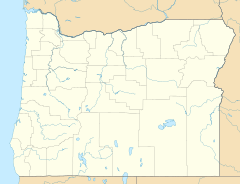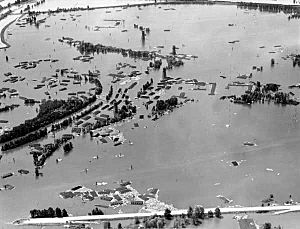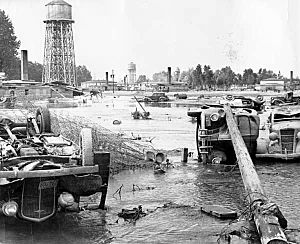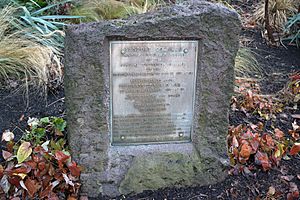Vanport, Oregon facts for kids
Quick facts for kids
Vanport, Oregon
|
|
|---|---|
|
Former city destroyed by flood
|
|
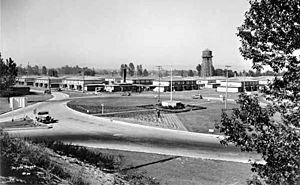
Vanport in 1943, five years before the flood
|
|
| Country | United States |
| State | Oregon |
| County | Multnomah |
| Elevation | 23 ft (7 m) |
| Time zone | UTC-8 (Pacific) |
| • Summer (DST) | UTC-7 (Pacific) |
| GNIS feature ID | 1128512 |
Vanport, also known as Vanport City or Kaiserville, was a special city built in Multnomah County, Oregon. It was located between the city of Portland and the Columbia River. This city was created during World War II to provide homes for workers. Sadly, a big flood in 1948 completely destroyed Vanport, and it was never rebuilt. Today, the area where Vanport once stood is home to Delta Park and the Portland International Raceway.
Contents
The Story of Vanport: A City Built for War
Vanport was built very quickly starting in August 1942. Its main purpose was to house the many people who came to work at the Kaiser Shipyards in Portland and Vancouver, Washington. These shipyards were building ships for the war effort.
How Vanport Became Oregon's Second Largest City
The name "Vanport" is a mix of "Vancouver" and "Portland." At its peak, Vanport was home to about 40,000 people. About 40% of these residents were African-American. This made Vanport the second-largest city in Oregon at the time. It was also the biggest public housing project in the entire country.
Life in Vanport After the War
After World War II ended, many wartime workers left the area. Because of this, Vanport's population dropped to about 18,500 people. However, many soldiers returning from the war, known as World War II veterans, moved into Vanport. To help these veterans and their families, the Housing Authority of Portland opened a college called the Vanport Extension Center. This school later grew into what is now Portland State University.
The Flood That Destroyed Vanport
Vanport was tragically destroyed on May 30, 1948. At 4:05 p.m., a 200-foot section of a railroad wall, which was holding back the Columbia River, broke apart. This happened during a major flood known as the 1948 Columbia River flood. The city was completely underwater by nightfall. About 18,000 people were left without homes. Sadly, 15 people lost their lives in the disaster.
Who Lived in Vanport?
Vanport was a place where people from all over the country came to work. Most residents were temporary workers, so they didn't have many long-term connections with each other. This made it hard for them to build a strong community.
Why People Moved to Vanport
Many families started moving out of Vanport by 1943-1944. A survey asked former residents why they had moved there. The top reason was that they felt it was their duty to help with defense work during the war. Other reasons included wanting a better job and higher pay.
Supporting Veterans in Vanport
After the war ended in 1945, the Housing Authority of Portland (HAP) wanted to attract World War II veterans. These veterans needed homes and communities to raise their families. They also wanted to use the Servicemen's Readjustment Act (G.I. Bill) to get a higher education. Opening a college in Vanport in 1946 was a key step to keep Vanport a busy and important community in Oregon.
Race Relations in Vanport
The building of Vanport brought many African-Americans to Oregon. They came to work in the wartime defense industries, which had recently stopped separating workers by race. Before the war, Oregon had very few Black residents because of old laws that kept them out. By 1946, over 15,000 Black people lived in the Portland area, mostly in Vanport and other specific housing areas.
Life for African-Americans in Vanport
Vanport was different from Portland in its social rules. People who moved to Vanport brought their own ideas about race from different parts of the country. Some white people from the South did not like how much integration (mixing of races) was happening in schools, buses, and workplaces. However, the Housing Authority of Portland (HAP) did not agree with these complaints. They never legally separated people by race in any of Vanport's facilities.
Even though HAP did not have a policy to separate people, it often happened naturally. White residents sometimes complained if they were placed near "Black" areas. In 1944, people started complaining about this separation. After some pressure, including from Eleanor Roosevelt, HAP began placing Black residents into "white" areas. However, many white residents protested, and HAP decided to go back to its old ways.
Challenges and Integration
Even with some separation, Vanport had a high level of integration for its time. There were no major racial fights or serious tensions. However, there were still challenges. A study from 1943-1944 showed that some of the top complaints from Vanport residents included "negroes and whites in same neighborhood" and "negroes and whites in same school." There were also complaints about "discrimination against Vanport people by Portlanders."
After the flood, many Black residents moved to North and Northeast Portland. Some Black leaders believed that the flood actually helped the Black community. They felt Vanport was a "ghetto" where Black people lived in ways similar to the South. The flood, they argued, allowed Black people to become more integrated into Portland's wider society.
The Vanport Flood of 1948
Vanport was built on low-lying land next to the Columbia River, which made it very open to flooding. The Columbia River Basin is a huge area that includes seven U.S. states and parts of Canada. Before the flood, there was a lot of snow in the mountains, and then warm temperatures caused it to melt quickly. Two big rainstorms in May 1948 added even more water. This caused the river to swell to levels not seen since 1894. The lowest part of Vanport was about 15 feet below the river's water level.
Warnings and Evacuation Efforts
The night before the flood, a radio alert was sent out. Some residents moved their belongings to higher floors. But few people thought the water would rise as much as it did. Also, many residents relied on public transportation, which made it harder for them to leave quickly.
On the morning of Memorial Day, May 30, 1948, the Housing Authority of Portland (HAP) released a statement that said: "Remember: Dikes are safe at present. You will be warned if necessary. You will have time to leave. Don't get excited."
The Levee Breaks
At about 4:17 p.m., the railroad wall (called a berm) burst. A 10-foot wall of water rushed into the area where Vanport College was located. A historical marker says the break happened at an old railroad cut that had been filled in. Because there were many small waterways in the area, the flood's progress was slowed by about 30 minutes. This extra time gave residents more opportunity to escape.
An emergency siren started sounding soon after the break. Residents began heading up North Denver Avenue to higher ground.
Aftermath of the Flood
At the time of the flood, Vanport's population was around 18,500 people. Since it was a holiday, many residents were away from their homes. These factors helped keep the number of deaths low; officially, only 15 people died. However, the entire city was completely destroyed.
On June 11, 1948, President Harry S. Truman flew to Portland to see the damage. Organizations like Vanport College and the Red Cross helped with the recovery efforts.
Vanport's Lasting Impact
Vanport played a big role in integrating Black people into Portland and Oregon. The first Black teachers and police officers in the state were hired in Vanport during the war years. One of these teachers, Martha Jordan, later became the first Black teacher hired by Portland Public Schools.
Preventing Future Floods
To prevent similar disasters, Congress passed the Flood Control Act of 1950. This led to projects like the Priest Rapids Dam. The flood also resulted in the 1961 Columbia River Treaty and the later building of Libby Dam in Montana.
Vanport's Legacy Today
The loss of Vanport is thought to have contributed to the closing of the Jantzen Beach Amusement Park in 1970. Several acres of the former city became "West Delta Park," which is now the Portland International Raceway.
The Vanport Extension Center refused to close after the flood. It quickly reopened in downtown Portland. A national magazine called it "The College that Wouldn't Die." This college eventually became today's Portland State University.
Since 2016, the Vanport Mosaic Festival has been held every year. This festival helps remember the city of Vanport and its important history.


